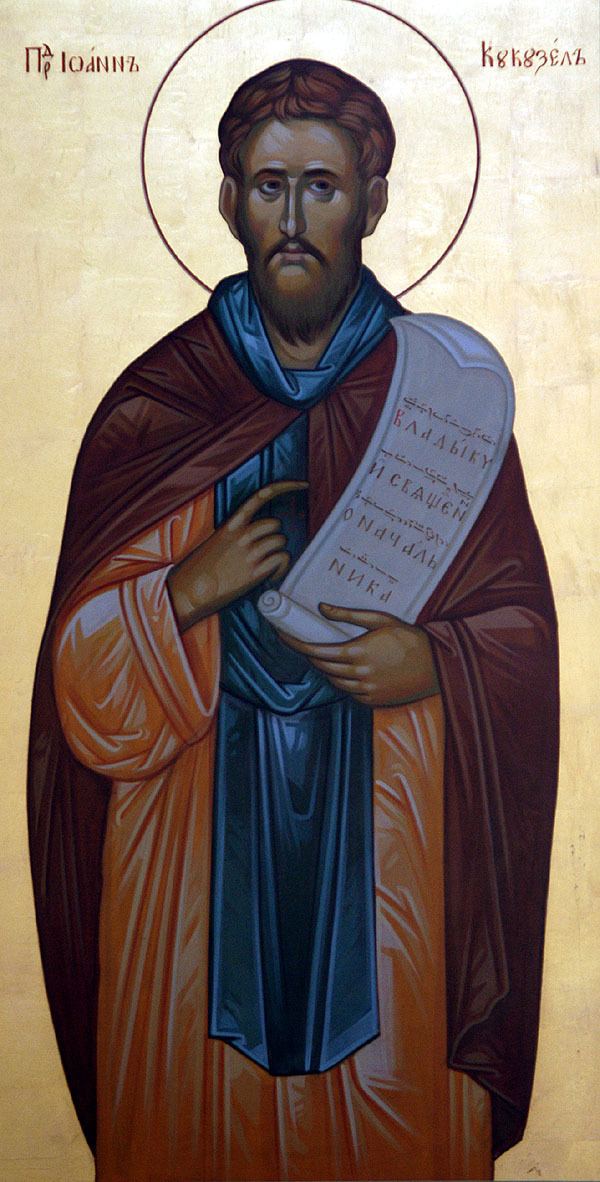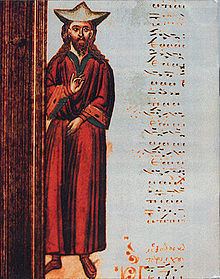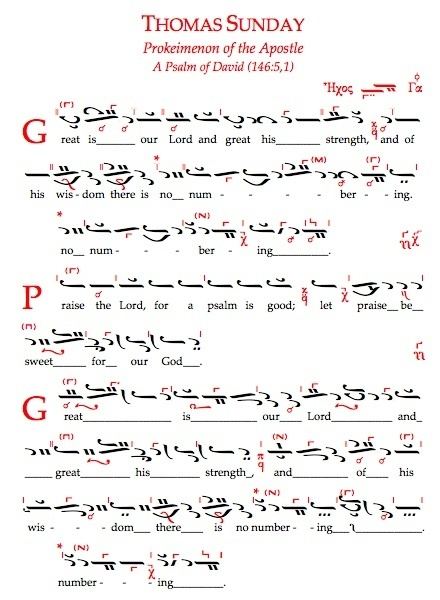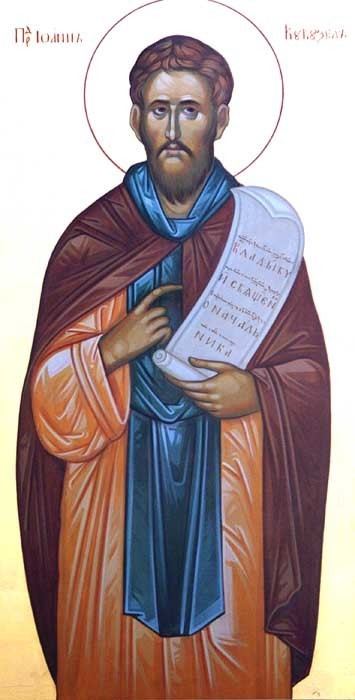Other names Jan Kukuzeli Role Composer Occupation singer, composer | Denomination Eastern Orthodoxy Name John Koukouzelis | |
 | ||
Known for Reformer of Orthodox Church music | ||
st john koukouzelis
John Koukouzelis or Jan Kukuzeli (Albanian: (Shën) Jan Kukuzeli; Bulgarian: Йоан Кукузел, Yoan Kukuzel; Greek: Ιωάννης Κουκουζέλης, Ioannis Koukouzelis; c. 1280 – c. 1360) was an Albanian-Bulgarian medieval Orthodox Christian composer, singer and reformer of Orthodox Church music.
Contents
- st john koukouzelis
- St John Koukouzelis
- Early life
- His contribution as a master of psaltic art
- Reception history of Koukouzelian compositions
- Sainthood and legacy
- References

Св. Йоан Кукузел (St. John Koukouzelis) - Полиелей на българката
Early life

Koukouzelis was born in Durazzo, at the time part of the Angevin Kingdom of Albania in the late 13th century to an Albanian father and a Bulgarian mother. He was orphaned in childhood.
According to some sources he was born in Džerminci, near Debar, which is presently uninhabited. Koukouzelis' last name is allegedly derived from the Greek word for broad beans (κουκιά, koukia) and a Slavic word for cabbage (зеле, zele).

Most scholars, including David Marshall Lang, state that his mother was simply of Bulgarian origin, while Robert Elsie generalizes her as being of Macedonian Slav descent. However, according to Raymond Detrez, despite that his mother may have been a Bulgarian, her Slavic origin is obscure.

At a young age, he was noted and accepted into the school at the imperial court at Constantinople.
His contribution as a master of psaltic art

Koukouzelis received his education at the Constantinople court vocal school and established himself as one of the leading authorities in his field during the time. A favourite of the Byzantine emperor and a principal choir chanter, he moved to Mount Athos and led a monastic way of life in the Great Lavra. Because of his singing abilities, he was called "Angel-voiced".
Koukouzelis established a new melodious ("kalophonic") style of singing out of the sticherarion. Some years after the fall of Constantinople Manuel Chrysaphes characterised the sticheron kalophonikon and the anagrammatismos as new genres of psaltic art which were once created by John Koukouzelis. Despite his innovations, Manuel assured that John Koukouzelis never contradicted the traditional method of the old sticherarion, not even in his anagrammatismoi.
But, O my friend, do not think that the manner of the whole musical art and its practice is so simple and uniform that the composer of a kalophonic sticheron [the soloistic sticheron kalophonikon (στιχηρὸν καλοφωνικὸν)] with appropriate theseis who does not adhere to the manner of old sticheron [the conventional simple way to perform a sticheron with two choirs] can think that he has done well and that which he has written quite good and free from every condemnation – since, if what he has composed does not include the method of the old sticheron, it is not correct. Do not think therefore, that the performance of chant is simple, but rather that it is complex and of many forms. [...] Thus even in the kalophonic stichera the composers of these do not depart from their original melodies [τὰ ἰδιόμελα] but follow them accurately, step by step, and retain them. Therefore, they take over some melodies unchanged from tradition and from the music thus preserved (as it is recorded in the old Sticherarion [the simple sticherarion according to the redaction and its variants since the 14th century]), and they all follow the path unaltered throughout the entire composition. The second composer always follows his predecessor and his successor follows him and, to put it simply, everyone retains the technique of the art. [...]
Ioannes Koukouzeles, the maistor, does not alter the stichera in his anagrammatismoi [the more deliberate compositions of a sticheron kalophonikon about the final section of a certain sticheron which usually also changed its text and reworked its melodic structure], but follows them step by step, although, like composers now, he was entirely able (indeed he was much more able) to create his own original chants which had nothing in common with their prototype stichera [the simple sticheron as it was traditionally notated in the books of the sticherarion]. But, had he acted thus, he would neither acted correctly nor would he have thought that he had interpreted the science of composition befittingly. Therefore, he follows the path of the old stichera precisely and does not alter them at all, obeying the rules of the science.
The school of John Glykys and his followers like John and Xenos Korones created the "Late Byzantine" system of round notation. But the use of just one notation system could seduce to the conclusion, that every chant genre has to be performed in the same way. Instead a huge number of different methods had to be observed, which were part of an oral tradition, sometimes even of a particular one which depended on a certain local school. However, the notation itself is sometimes not regarded as one system of its own, since it simply continued an already existing synthesis of many different notations (like the one of the asmatikon) within the notation developed in the monastic books of the sticherarion and the heirmologion. John Koukouzelis is also regarded as the creator of a new chant book which replaced the former books of the cathedral rite, the book of the choir (asmatikon), and the book of the lampadarios or monophonaris who sometimes replaced the left choir. The latter book was called "psaltikon" or "kontakarion", while the new book which combined the content of the older books, was called "order of services" (τάξις τῶν ἀλολουθίων) and these manuscripts are conventionally ascribed to John Koukouzelis. The Constantinopolitan redaction of the sticherarion and the heirmologion during the fourteenth century were often ascribed to John as well, but it was obviously neither the redaction of just one scribe, nor did the new kalophonic method intend any changes which contradicted the traditional ways. John Koukouzelis was obviously just one among a group of very talented musicians and reformers. Nevertheless, his legendary reputation caused that he is often identified with the reform itself. This identification is a common phenomenon in many Oriental and Andalusian traditions whose orally based transmission had never been completely abandoned.
The kalophonic method of John Koukouzelis can be studied by means of a vocal exercise "Mega Ison" which offered 60 designations of vocal signs. Also this didactic chant was a redaction of a similar one by John Glykys which probably developed from a simple list of notation signs as an essential part of a treatise genre called Papadike. The "exercise" (mathema) Mega Ison instead is a complex composition whose melos changes between all the echoi of the Papadic octoechos.
Reception history of Koukouzelian compositions
In general it is useful to make a distinction between compositions which can be verified as the compositions by John Koukouzelis, and those which are simply based on the method which he taught (as a stylistic category based on the kalophonic melos as exemplified by Mega Ison). Even concerning famous compositions, their authorship is often a subject of scholarly debates whose concern is not always the talent of one individual composer—like the Polyeleoi of the Bulgarian Woman dedicated to his mother that, according to some researchers, contains elements of traditional Bulgarian mourning songs. Greek editions of the same Polyeleos are different and especially the authorship of the Kratema used in the Bulgarian edition has been a controversial issue. Concerning stichera kalophonika, there are numerous compositions made up in his name, but his authorship must be regarded as a certain school which had a lot of followers and imitators.
Modern print editions of chant books have only a very few compositions (different melismatic echos varys realisations of Ἄνωθεν οἱ προφήται, several Polyeleos compositions, the cherubikon palatinon, the Mega Ison, the Anoixantaria) which are almost never sung, except the short Sunday koinonikon, for the very practical reason that most of John Koukouzelis' compositions, at least based on the exegetic transcriptions by Chourmouzios Chartophylakos (GR-An Ms. ΜΠΤ 703), are simply too long.
Sainthood and legacy
Koukouzelis is regarded as the most influential figure in the music of his period. He was later recognized as a saint by the Eastern Orthodox Church, his feast day being on 1 October. He is known as Saint John Koukouzelis (Greek: Άγιος Ιωάννης Κουκουζέλης, Hagios Ioannis Koukouzelis, Bulgarian: Свети Йоан Кукузел, Sveti Yoan Kukuzel, Albanian: Shën Jan Kukuzeli, Macedonian: Свети Јован Кукузел, Serbian: Свети Јован Кукузељ).
A musical school in his native Durrës bears his name. Kukuzel Cove in Livingston Island in the South Shetland Islands, Antarctica is named after Koukouzelis, using the Slavic form of his name.
